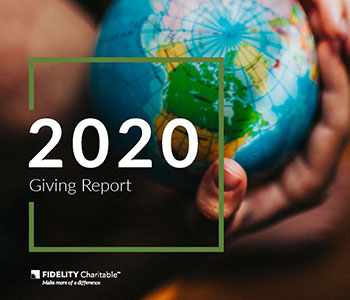What is this Report?

This report is a review of Fidelity Charitable Donor Advised Funds (DAFs)in 2020. By looking at 138,019 accounts (which is a snapshot since the number fluctuated during the year), Fidelity Charitable reported on the demographics of donors to DAFs, causes supported, and other metrics.
What are Key Findings of this Report?
- Donor Advised Funds are continuing to grow. 225,000 donors at Fidelity Charitable made 1.5M donor-recommended grants totaling $7.3B in 2019, a 39% increase from 2018. In 2019 Giving USA reported that donor advised funds were 3% of all charitable giving in 2018.
- Demographics of who is opening an account is changing. While most donors establish accounts in their 50s (79% of account holders are over 50), younger folks are starting to ramp up their giving through Donor Advised Funds. Millennials opened 13% of DAFs in 2019 compared to only 6% in 2014. But they are more likely to make a donation to the ALCU or Wikimedia, environmental organizations, and health organizations.
- Categories of causes supported by Donor advised funds mirror USA’s general giving. Religion is number one with education as number two. This remains true with Millennials. However, International Affairs are included in Millennial’s top 5. But the most popular charities in 2019 were Planned Parenthood and ACLU.
- Donors are using Fidelity Charitable to convert non-cash assets into contributions. Over 60%of contributions came from non-cash assets, like stocks.
- It doesn’t take a lot to open an account. Donors can open an account for $5,000. 54% of accounts have less than $25,000; 37% have between $25,000 and $250,000; and 9% have more than $250,000. In the National Philanthropic Trust 2019 report on DAFs from 2014–2018, the average size of a donor-advised fund was $166,653 in 2018, a big difference from Fidelity Charitable.
- Donors are loyal to their charities with DAFs. In 2019, 74% of grants went to a nonprofit that the donor had already supported in the past. Twenty-five percent or so were pre-scheduled or recurring.
- Donors make the majority of their grants unrestricted. 60% of grant recommendations are for unrestricted funds. This is a contrast with other modes of thought that donors want their funds to go to restricted funds.
- Great news for prospect researchers: Most donors include their names and addresses on grants. Eighty-eight percent of donors include this information; 9%only include their giving account name and 3% are anonymous.
- Contributions do not sit in accounts. Three-quarters of grants are made within 5 years. According to Pam Norley, president of Fidelity Charitable, Fidelity now has a policy that if the DAF has not made a grant in three years, Fidelity will take five percent and donate it via an independent board of trustees. If the fund doesn’t give in the fourth year, Fidelity will give it all to charity.
What Can I Do as a Result?
- Nonprofits should keep a close eye on grants from donor advised funds. Donors behind the DAFs should still be tracked and thanked with care because they are showing obvious support of your organization. This may require a tweak to the gift entry process to identify DAF owners via DAF name or otherwise.
- Fundraisers should realize that this new tool doesn’t necessarily mean the end of fundraising as they know it. DAF giving categories are similar to the general trend. Donors, moreover, are giving through many vehicles; DAFs are only one tool of many to make a gift.
- Charities should look at ways to facilitate the conversion of non-cash assets. Since donors are donating a lot of non-cash assets to DAFs, this suggests a need for charities to do a better job at facilitating conversions of stock, cryptocurrencies, etc. Charities ought to make it easy for donors to give in the way they want to give. The National Philanthropic Trust notes that in the 2018, the growth of contributions to donor-advised funds was higher than the growth of grants made from donor advised funds, possibly as a result of the tax law. However, they predict that donors may soon reverse the trend and give more from their donor advised funds.
- Be on the lookout for companies that make employee matching gifts to DAFs. National Philanthropic Trust notes that there is a rising trend for some companies to allow payroll deductions to DAF and/or match employee giving to funds from DAFs. For example, American Express will match contributions from a DAF but not made to a DAF or to establish a DAF.
Additional Resources
- 2020 Fidelity Charitable Giving Report | Fidelity Charitable 2020
- Fidelity Charitable Leader on the Most Popular Causes for Donor-Advised-Fund Gifts | Chronicle of Philanthropy 2/2020
- Donor Advised Funds and Donor Research: How They Can Work Together | Giving USA 2019
- The 2019 DAF Report | National Philanthropic Trust
- Donor-Advised Funds: Are DAFs Eligible for Matching Gifts? | 8/2013 Double the Donation